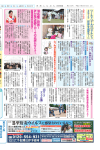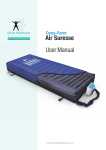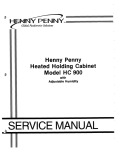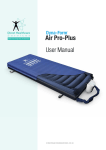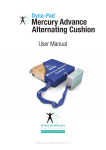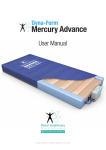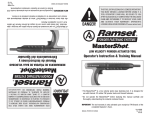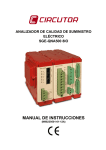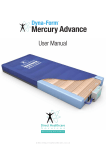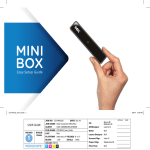Download Service Manual
Transcript
Service Manual DIRECTHEALTHCARESERVICES.CO.UK DYNA-FORM AIR PRO-PLUS 2 DIRECTHEALTHCARESERVICES.CO.UK SERVICE MANUAL Definition of Symbols Used Caution: Warning of possible hazard to system, patient or staff. Warning of possible electrical hazard. Important operational information. Contents Control Unit�������������������������������������������������������������������������������������������������������������������������������������������������������������������������4 Internal Descriptions������������������������������������������������������������������������������������������������������������������������������������������������������������5 Basic System Checks�����������������������������������������������������������������������������������������������������������������������������������������������������������7 Fuse Check and Replacement����������������������������������������������������������������������������������������������������������������������������������������������8 Printed Circuit Board (PCB) Check�����������������������������������������������������������������������������������������������������������������������������������������9 Printed Circuit Board (PCB) Replacement .............................................................................................................................10 Standard Pressure Test ......................................................................................................................................................11 Compressor Replacement ..................................................................................................................................................13 Synchronous Motor Replacement . ......................................................................................................................................15 Connector Replacement .....................................................................................................................................................18 Connector Plate Replacement .............................................................................................................................................19 Air Filter Maintenance ........................................................................................................................................................21 Rubber Feet Replacement ..................................................................................................................................................22 Hanging Hook Replacement . ..............................................................................................................................................24 Troubleshooting ................................................................................................................................................................26 Safety . .............................................................................................................................................................................29 Care & Cleaning ................................................................................................................................................................30 DIRECTHEALTHCARESERVICES.CO.UK 3 DYNA-FORM AIR PRO-PLUS The following section outlines the steps and procedures to follow if there is a suspected fault in the Control Unit. If a repair seems unmanageable or the issue falls outside the scope of serviceable repairs, please return the Control Unit to the Manufacturer. Malfunction of the Control Unit may be due to the failure of one of the replaceable electrical components of the Control Unit, including the compressor, print circuit board and timing motor rotary valve. Alternatively, a lack or loss of system pressure can be attributed to a variety of causes, including an incorrectly attached CPR Tag; a loosely connected or leaking Air Cell; leaking Air Hose; or faulty fuse. Insufficient system pressure is identified when the Visible LED flashes, and the corresponding Pressure Setting Warning signals display. Should the Control Unit fail to operate, or system pressure fail to reach normal operating status, please follow the steps below to isolate the cause of the problem and make the relevant repair. 4 DIRECTHEALTHCARESERVICES.CO.UK SERVICE MANUAL The electronically controlled Control Unit provides the air supply to the Mattress. The unit is operated by a digital touch membrane on the front display panel which controls eight comfort pressure settings; Alternating or Static Mode for treatment or transfers respectively; Max Firm mode for rapid inflation to maximum pressure to create a firm surface; and Control Unit Lockout to prevent accidental changes to the settings. The Visual LED indicator and Audible Mute completes the operator controls. The visible and audible function has a number of LED indication sequences depending on the cause of the failure. On the side of the unit are two air connectors (male and female) for quick connection of the two hole handle. The connectors include a press button release system for ease of use. The mains supply to the unit can be easily disconnected and is designed to detach if pulled too firmly – protecting the internal wiring from damage. The quality of the Control Unit underpins the reliability and pressure reduction capabilities of the System. At the centre of the Control Unit lies the compressor, which runs at a rapid and continuous rate whenever the unit is operational. Continuous rapid movement places compressor materials under high stress and heat conditions, which can make the unit susceptible to wear and tear over a long period of time. To minimise noise and vibration, the compressor is housed within a strong metal cage, secured on all sides by rubber mounts. These mounts serve to insulate the rest of the unit from the vibration of the compressor. 1 Printed Circuit Board (PCB) 2 Compressor 3 Compressor Cage 4 Static Actuator 5 Alternation Timer Motor 6 Power Socket (IEC Connector) 7 Audible Warning Speaker 8 Safety Fuse 9 Quick Release Air Hose Connector - Female 3 2 1 Quick Release Air Hose Connector - Male 10 11 Connector Plate 8 12 Rubber Feet 10 9 7 11 11 DIRECTHEALTHCARESERVICES.CO.UK 5 4 5 DYNA-FORM AIR PRO-PLUS Basic System Checks Before commencing any service procedure, the following basic checks should be completed to ensure that system fault or failure is not due to an oversight on behalf of the user. Set up the system and check the following: 2 C heck the Air Hoses are securely attached to the Control Unit (they should ‘click’ on). 1 E nsure all power cords and leads are firmly attached and that the system is connected to a working power source (with correct voltage). 3 Remove the Mattress Top Cover and check the deflation valve is firmly connected. 4 C heck each Air Cell is firmly connected to the internal air hose/s. Once these simple checks are complete, proceed with the service and repair as outlined in the following procedures. Service Procedure Flowchart Follow the flowchart to establish the recommended steps for system check and repair. Control Unit is inoperable (Display Panel fails to activate when unit is connected to a power source) YES NO Fuse Check and Replacement STILL INOPERABLE fails to reach operation pressure or loses pressure Basic System Checks YES (check power & power cords; Air Hose Attachments; CPR Tag; Air Cell attachment) STILL LOW PRESSURE FIXED the motor is ‘grinding’ or making an unusual sound OTHER PROBLEM Standard Pressure Test PRESSURE NOT OK FIXED Control Unit is operational but Compressor Replacement NOT FIXED YES Synchronous Motor Replacement PCB Replacement FIXED Return to Manufacturer PRESSURE OK FIXED NO CONFIRMS FAULTY PCB CHECK FAILS FIXED Control Unit is operational but 6 Printed Circuit Board (PCB) Check NOT FIXED Return to Manufacturer Return to Manufacturer DIRECTHEALTHCARESERVICES.CO.UK PRESSURE OK Air Leak Test DEFLATING Air Cell Replacement FIXED SERVICE MANUAL Fuse Check and Replacement Testing fuse for damage and replacing a blown fuse Control Unit failure may be the result of a blown fuse. Always check the fuse before opening the unit and performing any other internal component test procedures. Note: When changing the replaceable fuse, use same rating fuse only (T1AL/250V). The following tools are required: • Flat Head Screwdriver The following replacement parts are required: 1 S witch off power supply to the Control Unit and remove the power cord from the electrical socket in the base of the unit. 2 Using a level surface, place the Control Unit on its base, with easy access to the black round fuse cap located on the side of the unit (closest to the connectors). 3 Insert a small screwdriver into the groove on the fuse cap and turn counterclockwise in the direction of the arrow (quarter turn) to remove the fuse plug and single fuse. 5 Insert a new fuse (or the undamaged fuse) into the plug. Push against the force of the spring and turn clockwise with the screwdriver (quarter turn). 6 Reconnect the power cord to the Control Unit and switch on power supply. If Control Unit still fails to operate, the problem may be due to a faulty circuit board. Proceed to Printed Circuit Board Check procedure. If the unit switches on but fuse “blows” again, repeat the steps to replace the damaged fuse but do not reconnect power as damage may be due to a faulty compressor. Proceed to Standard Pressure Test procedure. • 250V fuse (M8260138) 4 V isually inspect the fuse – check if the metal filament inside the fuse cylinder is disconnected or snapped – and discard if damaged (or re-insert if undamaged). DIRECTHEALTHCARESERVICES.CO.UK 7 DYNA-FORM AIR PRO-PLUS Printed Circuit Board (PCB) Check Testing for a faulty circuit board by ‘piggybacking’ a working spare If the Control Unit still fails to operate after checking and replacing a damaged fuse, the next step is to test the Printed Circuit Board (PCB) for failure. To determine if the PCB has failed, always test the Control Unit using a working spare. The following tools are required: • Phillips Head Screwdriver • Wire Clippers The following spare parts are required: 1 S witch off power supply to the Control Unit, disconnect the Air Hoses and remove the power cord from the electrical socket in the base of the unit. 2 Using a soft cloth to protect the unit from damage, place the Control Unit on a level work surface with base facing upwards. 3 Use a Phillips Head Screwdriver to remove the four screws that secure the housing. Place the screws and washers in a safe place (such as small container or jar) to prevent loss. Hold the unit firmly and turn it over, face upwards on its base. 5 Disconnect the four electronic power leads by cutting the cable ties that secure the leads to the PCB. Carefully pull the plastic casing (not the wiring) to disconnect. 6 Disconnect the remaining three connections from the PCB (two flat digital leads and one air tube). Be sure to note the location of all seven connections on the circuit board for easy replacement. Leave the disconnected PCB in the Control Unit during testing. • 1 x PCB (in known working condition) (M8260143) 4 Gently loosen the top and bottom housing. Once loose, hold the power socket (IEC connector) to prevent from catching while lifting the top cover and leaning it back on your work surface. 8 B e careful not to drag the internal wires and tubing during this process. Before continuing, ensure no electrical leads are stretched and that all electrical connectors on the Printed Circuit Board (PCB) are firmly connected. You may need to prop the top housing case to prevent strain on the electrical cords. DIRECTHEALTHCARESERVICES.CO.UK SERVICE MANUAL Printed Circuit Board (PCB) Check 7 Take the working spare PCB and reconnect all seven leads into the corresponding connectors (four electronic leads; two digital; one air hose). 8 R econnect mains power, switch on the Control Unit and check the Display Panel. If the unit now operates, the internal PCB has failed and needs replacing. Proceed to the Printed Circuit Board Replacement procedure for next steps. If the Control Unit still does not operate, the unit needs to be returned to the Manufacturer for further repair or replacement. a S witch off power supply to the Control Unit, remove the spare PCB and reconnect the internal PCB (reconnect the seven power leads to the circuit board) before closing the housing. b R eturn the Control Unit to the Manufacturer in accordance with standard procedures. DIRECTHEALTHCARESERVICES.CO.UK 9 DYNA-FORM AIR PRO-PLUS Printed Circuit Board (PCB) Check Replacing a faulty circuit board Having established a fault with the PCB by following the Printed Circuit Board Check procedure detailed previously (steps 1 through 7), replace the faulty PCB with a new PCB. The following tools are required: • Needle Nosed Pliers • Phillips Head Screwdriver The following replacement parts are required: 8 S witch off power supply to the Control Unit before disconnecting the spare ‘test’ PCB. Disconnect all seven leads while noting the location of each lead on the circuit board. 9 Using Needle Nosed Pliers, unclip the PCB from the top housing. Note the orientation of the PCB before removing it from the unit. Dispose of the faulty PCB in an environmentally safe manner. 10 U npack the replacement PCB. Align the circuit board against the four holes and carefully reconnect the clips by pressing firmly into place. 12 B efore closing the housing, make sure all power leads and hoses are free from the side edges. Ensure the regulator tubing will not kink when the top cover is closed. 13 A lign the top and bottom housing before slowly pushing closed. Ensure the seal is properly aligned around the housing, including the air hose connectors, fuses and power connector. 15 U se a Phillips Head Screwdriver to replace the four screws plus washers and tighten to secure the housing together. • 1 x PCB (M8260143) 11 R econnect all seven leads into the corresponding connectors on the circuit board. 14 H olding the top and bottom housing firmly together, turn the Control Unit upside down, with base facing upwards. 10 DIRECTHEALTHCARESERVICES.CO.UK 16 C onnect the Control Unit to mains power and switch on the Control Unit to confirm operation. SERVICE MANUAL Standard Pressure Test Testing airflow and checking for a faulty compressor The Control Unit compressor is designed for long life, and backed by a two-year warranty from the Manufacturer, however compressor failure can occur and will require replacement. The Standard Pressure Test should be carried out to check the compressor is working at full operational capacity and that sufficient airflow is being generated to maintain maximum Mattress specifications. By directly connecting the compressor to the Pressure Test Equipment (Sphygmomanometer and Air Flow Meter), this test will confirm system pressure readings at maximum and minimum airflow (in free flow mode or with different degrees of back pressure applied). If the Pressure Test fails and pressure readings do not match required settings, the compressor should be replaced and the test repeated. The Control Unit must be allowed to “warm up” before undertaking the Standard Pressure Test, to ensure the diaphragm inside the compressor has loosened and is operating at maximum capacity. After opening the unit, reconnect power and allow the system to run for a minimum of thirty minutes before commencing this test. The following tools are required: • Phillips Head Screwdriver • Pressure Test Equipment > Sphygmomanometer (mmHg reading) > Air Flow Meter (Lpm reading) 2 U sing a soft cloth to protect the unit from damage, place the Control Unit on a level work surface with base facing upwards. Pressure Test Equipment Set Up One air hose is connected to the rear of the Sphygmomanometer and another to the base of the Air Flow Meter. These two air hoses are then connected by a ‘Y’ piece to form a single air hose outlet. Check all hose attachments are secure before commencing the test. Initially set the equipment to free flow mode – ensure the airflow valve at the front of the Air Flow Meter is fully open (turn the valve clockwise to open). 3 U se a Phillips Head Screwdriver to remove the four screws that secure the housing. Place the screws and washers in a safe place (such as small container or jar) to prevent loss. Hold the unit firmly and turn it over, face upwards on its base. 1 S witch off power supply to the Control Unit, disconnect the Air Hoses and remove the power cord from the electrical socket in the base of the unit. 4 G ently loosen the top and bottom housing. Once loose, hold the power socket (IEC connector) to prevent from catching while lifting the top cover and leaning it back on your work surface. Be careful not to drag the internal wires and tubing during this process. Before continuing, ensure no electrical leads are stretched and that all electrical connectors on the Printed Circuit Board (PCB) are firmly connected. You may need to prop the top housing case to prevent strain on the electrical cords. DIRECTHEALTHCARESERVICES.CO.UK 11 DYNA-FORM AIR PRO-PLUS Standard Pressure Test 5 R econnect the Control Unit to mains power and switch on. The unit must run for a minimum of 30 minutes to “warm up” before pressure testing commences. Leave the unit in a safe place during the warm up period. a Ensure the equipment is set to ‘free flow mode’ (i.e. no resistance or back pressure against the full flow of air from the compressor). The valve at the front of the Air Flow Meter should be fully open. If not, turn clockwise to open the valve to maximum. With the system in free flow mode, the ball bearing inside the Air Flow Meter should rise to a minimum of 4.5+ litres per minute. The Sphygmomanometer pressure reading should be low (approximately 10 mmHg). 12 6 A fter the 30 minute “warm up” period has elapsed, detach the internal air hose from the compressor (some force may be required) and replace with the air hose from the Pressure Test Equipment (for directly connection to the compressor). Push the air hose firmly until it fully covers the connector. b S lowly close the valve on the Air Flow Meter to reduce airflow air and simulate ‘back pressure’ (i.e. to emulate the weight of a patient lying on the mattress, which forces pressure back against the flow of air from the unit). Slowly close the valve until the Sphygmomanometer pressure reading reaches 30 mmHg. At 30 mmHg, the ball bearing inside the Air Flow Meter should drop to a minimum of 3+ litres per minute. To check operational capacity of the compressor, test each pressure setting as outlined in the following steps. The table above right, summarises c Continue to increase back pressure resistance. Slowly close the valve on the Air Flow Meter until the Sphygmomanometer pressure reading reaches 60 mmHg. At 60 mmHg, the ball bearing inside the Air Flow Meter should drop to a minimum of 2+ litres per minute. DIRECTHEALTHCARESERVICES.CO.UK Base Pressure mmHg Air Flow Lpm >10 4.5+ 30 3+ 60 2+ 120> 0 the expected pressure and air flow measurements. If air flow measurements fail to meet the specified minimum levels during any stage of the pressure test, the compressor is not operating at full capacity and needs to be replaced. Remember that a 30 minute “warm up” period is required.. d Finish testing by fully closing the Air Flow Meter valve (maximum resistance). The ball bearing inside the Air Flow Meter should drop to 0 and the Sphygmomanometer pressure reading should rise to 120+ mmHg. SERVICE MANUAL Standard Pressure Test e If air flow measurements fail to meet the specified minimum levels during any stage of the pressure test, the compressor is not operating at full capacity and needs to be replaced. Proceed to Compressor Replacement procedure. If all pressure and air flow measurements met the expected levels, the problem may be due to a leaking Air Cell or other defect with the Mattress. Close the Control Unit and proceed to Mattress procedures. 7 To close the Control Unit, first disconnect the Pressure Test Equipment air hose from the compressor and reattach the internal air hose, using gentle pressure to ensure a firm fit. 8 Before closing the housing, make sure all power leads and hoses are free from the side edges. Ensure the regulator tubing will not kink when the top cover is closed. 9 A lign the top and bottom housing before slowly pushing closed. Ensure the seal is properly aligned around the housing, including the air hose connectors, fuses and power socket. 10 H olding the top and bottom housing firmly together, turn the Control Unit upside down, with base facing upwards. 11 U se a Phillips Head Screwdriver to replace the four screws plus washers and tighten to secure the housing together. 12 C onnect the Control Unit to mains power and switch on the unit to confirm operation. DIRECTHEALTHCARESERVICES.CO.UK 13 DYNA-FORM AIR PRO-PLUS Compressor Replacement Replacing a faulty compressor Having established a fault with the compressor by following the completing the Standard Pressure Test procedure detailed previously (steps 1 through 6), replace the faulty compressor with a new compressor. The following tools are required: • Wire Clippers (or sharp knife) • Needle Nosed Pliers • Phillips Head Screwdriver The following replacement parts are required: 7 S witch off power supply to the Control Unit and remove the power cord from the electrical socket in the base of the unit before disconnecting the Pressure Test Equipment air hose. 8 Using Wire Clippers (or a sharp knife) carefully cut and remove the cable tie securing the power leads between the two halves of the unit. • 1 x Compressor (M8260139) • 1 x Cable Tie 10 U sing a Phillips Head Screwdriver 11 Unpack the replacement loosen the two screws at the end compressor. Carefully thread of the cage furthest from the air the power lead through the base hose inlets. Then remove the of the cage before sliding the screws closest to the air hose new compressor into position inlets, placing carefully aside. (with power lead closest to the Tilt the cage upwards to slide the PCB, and air hose connector compressor over the housing positioned towards base). struts. Ensure the compressor Replace the two screws before power lead does not get caught in tightening the loosened screws. the process. Dispose of the faulty compressor in an environmentally safe manner. 14 9 Check the internal compressor power lead and air hose is disconnected before removing the eight rubber mounts that secure the compressor within the metal cage. It is easier to extract each mount using a pair of needle nosed pliers to gently twist free rather than pulling directly with force. If rubber mounts break, make sure all pieces are removed from inside the unit. Undamaged mounts can be reused. 12 S ecure the compressor to the metal cage by connecting the eight new rubber mounts, starting with four mounts on one side of the cage (bottom followed by top), then four mounts on opposite side. When connecting mounts, it helps to prop or hold the compressor within the cage to better align the mount holes. Insert the tapered end of the rubber mount through the corresponding hole in the cage, gently pushing through until the mount can be twisted around the nose of the pliers and pulled firmly into place DIRECTHEALTHCARESERVICES.CO.UK SERVICE MANUAL Compressor Replacement 13 V isually check that each mount is secure – gently move the compressor within the cage to ensure all mounts are connected and the compressor is correctly suspended with the metal cage. 14 R eattach the air hose to the compressor, using gentle pressure to ensure a firm fit. 15 R econnect the compressor power lead to the circuit board and attach a new cable tie to secure all power leads as before. 16 B efore closing the housing, make sure all power leads and hoses are free from the side edges. Ensure the regulator tubing will not kink when the top cover is closed. 17 A lign the top and bottom housing before slowly pushing closed. Ensure the seal is properly aligned around the housing, including the air hose connectors, fuses and power connector. 18 H olding the top and bottom housing firmly together, turn the Control Unit upside down, with base facing upwards. 19 U se a Phillips Head Screwdriver to replace the four screws plus washers and tighten to secure the housing together. 20 Connect the Control Unit to mains power and switch on the Control Unit to confirm operation. DIRECTHEALTHCARESERVICES.CO.UK 15 DYNA-FORM AIR PRO-PLUS Synchronous Motor Replacement Replacing a faulty synchronous motor The synchronous motor runs the rotovalve that operates the timing mechanism for the alternation cycle. If the rotovalve becomes worn or damaged it no longer spins smoothly and the unit will emit a distinct ‘grinding’ noise. If you hear an uncharacteristic noise from the motor when the Control Unit is switched on, the synchronous motor needs to be replaced. The following tools are required: • Phillips Head Screwdriver • Wire Clippers (or sharp knife) • Flat Head Screwdriver (small) • 7/32 Inch Socket Wrench 1 S witch off power supply to the Control Unit, disconnect the Air Hoses and remove the power cord from the electrical socket in the base of the unit. 2 Using a soft cloth to protect the unit from damage, place the Control Unit on a level work surface with base facing upwards. 3 U se a Phillips Head Screwdriver to remove the four screws that secure the housing. Place the screws and washers in a safe place (such as small container or jar) to prevent loss. Hold the unit firmly and turn it over, face upwards on its base. 6 Trace the power lead running from underneath the synchronous motor to its connection on the circuit board. Disconnect this lead from the circuit board by carefully pulling the plastic casing (not the wiring) and gently remove the lead from under the compressor cage and leave it free. 7 U sing thumb and forefinger, push down firmly on the plastic rotovalve casing to release tension while removing the split pin – a deal of downward pressure is required. While maintaining downward pressure, take a small screwdriver or other implement to gently lift the split pin from the top of the motor shaft. Place the pin in a safe place for future replacement. The following replacement parts are required: • 1 x Synchronous Motor (M8260147) • 1 x Cable Tie 4 Gently loosen the top and bottom 5 Using Wire Clippers (or a sharp housing. Once loose, hold the knife) carefully cut and remove power socket (IEC connector) to the cable tie securing the power prevent from catching while lifting leads between the two halves of the top cover and leaning it back the unit. on your work surface. Be careful not to drag the internal wires and tubing during this process. Before continuing, ensure no electrical leads are stretched and that all electrical connectors on the Printed Circuit Board (PCB) are firmly connected. You may need to prop the top housing case to prevent strain on the electrical cords. 16 DIRECTHEALTHCARESERVICES.CO.UK SERVICE MANUAL Synchronous Motor Replacement The rotovalve is made of two plastic circular casings held together by lubricant material, and should remain attached during removal. If the top casing comes free during this process, place in a safe place until time to replace the rotovalve, when it can be reattached. 8 G ently lift the plastic rotovalve up and over the shaft, sliding the ‘L’ shaped metal bracket through the black plastic handle at the side of the rotovalve, to reveal the spring and synchronous motor beneath. 11 L ift the motor off its mounts and 12 U npack the replacement remove, ensuring the power lead motor. Carefully thread the does not get caught in the process. power lead under the base of Dispose of the faulty motor in an the compressor cage before environmentally safe manner. repositioning the new motor over the shaft and on its mounts, ensuring bolt holes are correctly aligned. 9 Remove the spring and place it in a safe place for future replacement. 10 U sing the socket wrench, unscrew the two bolts that hold the motor in place, noting the position of both the bolts and the ‘L’ shaped metal bracket (closest to the compressor). This bracket helps secure the plastic rotovalve casing to the motor and should also be removed and placed in a safe place with bolts for future replacement. 13 R eplace the ‘L’ shaped metal bracket over the bolt hole closest to the compressor – it must be positioned to accommodate the plastic handle on the rotovalve. If not correctly positioned, the rotovalve will move during operation. 14 T o test correct alignment of the motor and bracket, insert both bolts to secure the motor but finger tighten only. Gently place the rotovalve over the shaft to check the ‘L’ shaped bracket is correctly positioned to slide through the plastic handle at the side of the rotovalve. Once alignment is verified, remove the rotovalve and using the 7/32 inch socket wrench, tighten both bolts to firmly secure the motor in place. Be careful not to overtighten. DIRECTHEALTHCARESERVICES.CO.UK 17 DYNA-FORM AIR PRO-PLUS Synchronous Motor Replacement 18 15 R eposition the spring over the shaft, wider coils at the base (finer coils on top). 16 If the top plastic casing of the rotovalve has come lose, reposition it and hold firmly in place before replacing the rotovalve over the shaft, while sliding the ‘L’ shaped bracket through the plastic handle at the side of the rotovalve. 17 F irmly push down on the rotovalve while replacing the split pin through the top of the shaft. A significant amount of pressure is required to counteract the force of the spring. 18 R econnect the motor power lead to the circuit board and attach a new cable tie to secure all power leads as before. 19 T est the motor before closing the housing. Connect the Control Unit to mains power and switch on to ensure the motor works and rotovalve is turning (with no adverse noise). It the Control Unit fails to operate, the unit needs to be returned to the Manufacturer for further repair or replacement. Switch off power supply to the Control Unit before closing the housing. Return the Control Unit to the manufacturer in line with standard procedures. 20 Before closing the housing, make sure all power leads and hoses are free from the side edges. Ensure the regulator tubing will not kink when the top cover is closed. 21 A lign the top and bottom housing before slowly pushing closed. Ensure the seal is properly aligned around the housing, including the air hose connectors, fuses and power connector. 23 U se a Phillips Head Screwdriver to replace the four screws plus washers and tighten to secure the housing together. 22 Holding the top and bottom housing firmly together, turn the Control Unit upside down, with base facing upwards. DIRECTHEALTHCARESERVICES.CO.UK 24 C onnect the Control Unit to mains power and switch on the Control Unit to check function. SERVICE MANUAL Connector Replacement Replacing the air hose quick release connectors Both the male and/or female quick release connectors on the side of the Control Unit can be removed and replaced in the event of damage or breakage. Single connectors can be unscrewed and replaced in the event of individual damage. For more significant damage to the connector plate, or when damaged connector cannot be removed, the Connector Plate should be replaced. Proceed to the Connector Plate Replacement procedure. The following tools are required: • Adjustable Wrench The following replacement parts are required: • Male Connector (M8260121) • Female Connector (M8260122) 1 S witch off power supply to the Control Unit, disconnect the Air Hoses and remove the power cord from the electrical socket in the base of the unit. 2 U sing an Adjustable Wrench, unscrew the damaged quickrelease connector from the side of the unit by turning it counterclockwise – a degree of force may be required to initially loosen the connector. DIRECTHEALTHCARESERVICES.CO.UK 3 Insert the replacement connector (male or female as appropriate) and turn clockwise to tighten until firm. 19 DYNA-FORM AIR PRO-PLUS Connector Plate Replacement Replacing the Connector Plate If the inset Connector Plate is cracked or damaged, or if it is not possible to gain leverage on a damaged or snapped single connector for individual replacement, the Connector Plate must be replaced. The following tools are required: • Phillips Head Screwdriver • Adjustable Wrench The following replacement parts are required: 1 S witch off power supply to the Control Unit, disconnect the Air Hoses and remove the power cord from the electrical socket in the base of the unit. 2 Using a soft cloth to protect the unit from damage, place the Control Unit on a level work surface with base facing upwards. 3 U se a Phillips Head Screwdriver to remove the four screws that secure the housing. Place the screws and washers in a safe place (such as small container or jar) to prevent loss. Hold the unit firmly and turn it over, face upwards on its base. 6 Detach both internal air hoses from the inside of the Connector Plate and slide the damaged plate from the side of the unit. Dispose of the Connector Plate in an environmentally safe manner. 7 U npack the replacement Connector Plate and slide into place. Ensure the male and female connectors are securely inserted. Press firmly to reattach the internal air hoses as before. • Connector Plate 4 Gently loosen the top and bottom 5 Be careful not to drag the internal housing. Once loose, hold the power wires and tubing during this socket (IEC connector) to prevent process. Before continuing, from catching while lifting the top ensure no electrical leads are cover and leaning it back on your stretched and that all electrical work surface. connectors on the Printed Circuit Board (PCB) are firmly connected. You may need to prop the top housing case to prevent strain on the electrical cords. 20 DIRECTHEALTHCARESERVICES.CO.UK SERVICE MANUAL Connector Plate Replacement 8 B efore closing the housing, make sure all power leads and hoses are free from the side edges. Ensure the regulator tubing will not kink when the top cover is closed. 9 A lign the top and bottom housing before slowly pushing closed. Ensure the seal is properly aligned around the housing, including the air hose connectors, fuses and power connector. 10 H olding the top and bottom housing firmly together, turn the Control Unit upside down, with base facing upwards. DIRECTHEALTHCARESERVICES.CO.UK 11 U sing the Phillips Head Screwdriver to replace the four screws plus washers and tighten to secure the housing together. 21 DYNA-FORM AIR PRO-PLUS Air Filter Maintenance Cleaning and replacing the air filters Good filter maintenance is critical to maintain the Control Unit in optimal operating condition. Failure to maintain clean filters may result in system downtime and increased repair costs. It is recommended that the air filter be replaced each year as a minimum. Always check and replace air filters as part of any standard maintenance or service procedure. The following tools are required: • Fine Flat Head Screwdriver The following replacement parts are required: • 2 x Filters (M4248829) 4 Remove each foam air filter for cleaning or replacement. The foam air filters and filter casings may be washed with soap and water. Rinse with plain water and dry thoroughly before returning to the Control Unit. Alternatively refit with a new filter (recommended annually). 22 1 S witch off power supply to the Control Unit, disconnect Air Hoses and remove the power cord from the electrical socket in the base of the unit. 2 Using a soft cloth to protect the unit from damage, place the Control Unit on a level work surface with base facing upwards. 5 Replace both air filters and refit the filter covers, ensuring the clip snaps into place. DIRECTHEALTHCARESERVICES.CO.UK 3 U sing a suitable tool (such as 2mm flat head screwdriver), gently press the clip on each air filter cover to remove. SERVICE MANUAL Rubber Feet Replacement Replacing the rubber feet on the base of the unit The Control Unit has four rubber feet at each corner of the base of the unit, to cushion the unit when hanging against the foot of the bed or standing on the floor or other stable surface. On occasion, these rubber feet will fall out or become damaged. Missing or damaged rubber feet should be replaced to maintain the stability of the Control Unit. The following tools are required: • Phillips Head Screwdriver • Needle Nose Pliers The following replacement parts are required: 1 S witch off power supply to the Control Unit, disconnect Air Hoses and remove the power cord from the electrical socket in the base of the unit. 2 Using a soft cloth to protect the unit from damage, place the Control Unit on a level work surface with base facing upwards. 3 U se a Phillips Head Screwdriver to remove the four screws that secure the housing. Place the screws and washers in a safe place (such as small container or jar) to prevent loss. Hold the unit firmly and turn it over, face upwards on its base. 5 Be careful not to drag the internal wires and tubing during this process. Before continuing, ensure no electrical leads are stretched and that all electrical connectors on the Printed Circuit Board (PCB) are firmly connected. You may need to prop the top housing case to prevent strain on the electrical cords. 6 Lift the bottom housing up to access the base of the unit. For damaged feet, use the Needle Nose Pliers to hold the rubber base and remove from the casing. 7 U npack the replacement rubber feet. Insert the long nose of the rubber foot into the empty socket on the base of the unit (pushing from outside in). • Rubber Feet (Set of four) (M8260118) 4 Gently loosen the top and bottom housing. Once loose, hold the power socket (IEC connector) to prevent from catching while lifting the top cover and leaning it back on your work surface. DIRECTHEALTHCARESERVICES.CO.UK 23 DYNA-FORM AIR PRO-PLUS Rubber Feet Replacement 8 O nce through the hole, lay the bottom housing flat and use the Needle Nose Pliers to gently pull through until the rim of the foot locks into place. Move gently from side to side while pulling, rather than applying direct upward force, to avoid snapping the nose of the replacement foot. 9 B efore closing the housing, make sure all power leads and hoses are free from the side edges. Ensure the regulator tubing will not kink when the top cover is closed. 10 A lign the top and bottom housing before slowly pushing closed. Ensure the seal is properly aligned around the housing, including the air hose connectors, fuses and power connector. 12 U se a Phillips Head Screwdriver to replace the four screws plus washers and tighten to secure the housing together. 24 DIRECTHEALTHCARESERVICES.CO.UK 11 H olding the top and bottom housing firmly together, turn the Control Unit upside down, with base facing upwards. SERVICE MANUAL Hanging Hook Replacement Replacing the hanging hooks on the base of the unit Very rarely, the metal hanging hooks located on the base of the Control Unit will become damaged or worn. Either one or both hooks can be replaced. The following tools are required: • Phillips Head Screwdriver The following replacement parts are required: 1 S witch off power supply to the Control Unit, disconnect Air Hoses and remove the power cord from the electrical socket in the base of the unit. 2 Using a soft cloth to protect the unit from damage, place the Control Unit on a level work surface with base facing upwards. 3 G ently peel back the two foam mounting strips to reveal the plastic housing beneath. If careful enough, the foam mounts can be reused. 5 While holding the small silver bracket at the top of the spring with one hand, use the head of the hook to push against the spring and release the damaged hook. The hook will slide free from the spring and base mount. 6 Unpack the replacement hook and lay in position over the plastic bracket Ensure the flat side of the teeth sit against the unit. • Hanging Hooks (M8260117) 4 Use a Phillips Head screwdriver to unscrew the three screws that secure the plastic housing. Place the screws in a safe place (such as small container or jar) to prevent loss. Lift the plastic housing to reveal the spring connection. DIRECTHEALTHCARESERVICES.CO.UK 25 DYNA-FORM AIR PRO-PLUS Hanging Hook Replacement 7 S lide the hook into the spring and push the hook into the base mount. 8 Insert the ‘U’ shaped silver bracket over the shaft, between the teeth and the plastic bracket. 9 Replace the plastic housing and use the Phillips Head Screwdriver to replace the three screws to secure. 11 C heck the smooth movement of the hooks. 26 DIRECTHEALTHCARESERVICES.CO.UK 10 R eplace the foam mounting strip by aligning sticky side over housing and firmly pressing to adhere. If the original foam mounting is destroyed, peel protective back off new foam mounting and adhere. SERVICE MANUAL Troubleshooting The following section outlines a list of common troubleshooting issues, together with recommended initial checks and subsequent Technical Service steps and procedures to follow if there is a suspected fault in the System. If a repair seems unmanageable, the issue falls outside the scope of serviceable repairs or the problem persists following the recommended service checks and repair procedures, please return the faulty System (Control Unit; Mattress; or both) to the Manufacturer. Problem Cause Initial Checks Technical Service Procedure Control Unit does not operate; no display lights illuminate. The Control Unit may not be attached to a power source. The power cord may be damaged. A fuse may need replacing. 1. Check the Control Unit is connected to mains power outlet with the correct voltage. 2. Check the Control Unit is switched on. Switch off and disconnect the unit before restarting. 3. Check the Control Unit with a spare power cord (in known working condition). Control Unit Fuse Check and Replacement Control Unit Printed Circuit Board Check and Replacement Control Unit operational but red Visual LED illuminates (Mattress fails to reach or drops below accepted minimum level). The system may have an air leak. The Air Filters may need cleaning or replacing. 1. Check the Handle is securely attached to the Control Unit. 2. Check the CPR Tag is intact, ensuring all sealing connectors are fully fitted to the Mattress air pipes. 3. Check all pipes along the inside of the Mattress – each should be firmly connected. 4. Check each Air Cell and/or Side Bolster is securely attached to the connecting air pipe. 5. Check all cells, pipes and pipes for any air leakage. 6. Check air filter covers are secure and air filters are clean. Control Unit Air Filter Maintenance Control Unit Compressor Check and Replacement Mattress fails to inflate. The Control Unit is ‘grinding’ or making an unusual noise. The Synchronous Motor (timing motor) may be damaged. The Mattress is inflated but static head cells are still deflated. System may need more time to inflate – air pressure must build in alternating section before static head cells inflate. CPR Tag is not fully connected. Valves to static head cells may be damaged or cracked. Control Unit Synchronous Motor Replacement 1. Check system has had sufficient time for initial inflation (40 to 50 minutes). 2. Check the CPR Tag is intact, ensuring all sealing connectors are fully fitted to the Mattress air pipes. 3. Visually check the internal Mattress air pipes that run from the CPR Tag to the static head cells for splits, cracks or other damage. DIRECTHEALTHCARESERVICES.CO.UK Return System to Manufacturer for further repairs or replacement. 27 DYNA-FORM AIR PRO-PLUS Troubleshooting 28 Problem Cause Initial Checks Technical Service Procedure The Mattress is not alternating. Static or Max Firm modes may be activated. 1. Switch the Control Unit off and disconnect the power before restarting. Ensure Alternating Mode is selected. Synchronous Motor Replacement Patient is sinking or “bottoming out” while lying flat on Mattress. The pressure may be set too low for the patient’s weight. The system may be losing pressure. 1. Increase Pressure Setting – an incremental increase is usually sufficient but wait 12 minutes (one full cycle) before checking. 2.P erform “bottoming out” test: a. With patient lying supine, fold back one side of the Mattress Top Cover just past sacral region (lower spine). b. Slide hand underneath the patient and feel for a deflated cell under the patient’s lower spine. Any inner static cell will remain inflated however your hand should easily slide between patient and base. c. If patient is adequately suspended, pressure setting can be lowered however this test should be repeated after approximately 20 minutes. Mattress Service Procedures DIRECTHEALTHCARESERVICES.CO.UK SERVICE MANUAL Troubleshooting Control Unit warning indicators Technical Service Procedure Problem Cause Initial Checks Warning LED Initial failure 1. Reset the Warning LED – turn off Power and press the audible warning mute button. 2. Check the CPR Tag is intact, ensuring all sealing connectors are fully fitted to the Mattress air hoses. 3. Check all air hoses along inside of the Mattress – each should be firmly connected. Check each Air Cell is securely attached to its connecting air pipe. 4. Check all cells, pipes and hoses for any air leakage. 5. Switch on Power. Control Unit Fuse Check and Replacement 1. Reset the Warning LED – turn off Power and press the audible warning mute button. 2. Check the CPR Tag is intact, ensuring all sealing connectors are firmly fitted to Mattress air hoses. 3. Check all air hoses along inside of the Mattress – each should be firmly connected. Check each Air Cell is securely attached to its connecting air pipe. 4. Check all cells, pipes and hoses for any air leakage. 5. Check air filter covers are correctly secured and air filers are clean. 6. Switch on Power. Control Unit Air Filter Maintenance Pressure too high 1. Reset the Warning LED – turn off Power and press the audible warning mute button. 2. Disconnect the air hoses to reduce pressure – reconnect when pressure has decreased. 3. Check for twists in the air hoses between Control Unit and Mattress. 4. Switch on Power. Control Unit Standard Pressure Test Alternating Mode Failure (no alternation) 1. Reset the Warning LED – turn off Power and press the audible warning mute button. 2. Disconnect the air hoses to reduce pressure – reconnect when pressure has decreased. Control Unit Standard Pressure Test Power down 1. Press the audible warning mute button to silence the audible alarm. 2. C heck the power cord is firmly plugged into the Control Unit; check the Control Unit is connected to mains power outlet with the correct voltage. 3. C heck the Control Unit is switched on. Switch off and disconnect the unit before restarting. 4. C heck the Control Unit with a spare power cord (in known working condition). Control Unit Fuse Check and Replacement + audible warning Warning LED Pressure too low + audible warning Warning LED + audible warning Warning LED Control Unit Printed Circuit Board Check and Replacement Control Unit Compressor Check and Replacement + audible warning Warning LED + audible warning DIRECTHEALTHCARESERVICES.CO.UK Control Unit Printed Circuit Board Check and Replacement 29 DYNA-FORM AIR PRO-PLUS Safety General Safety Precautions Do not use this equipment in the presence of flammable anaesthetics. Explosions could result. The air intakes for the Control Units are at the sides of the unit. To avoid the risk of blocking these intakes, it is recommended that the unit be mounted on the footboard of a bed frame. Should the bed not have a suitable footboard, it is recommended that the unit be placed on a solid surface such as a table, or on the floor. Protection Against Hazards Fluids Avoid spilling fluids on any part of the Control Unit. If spills do occur: • Disconnect the unit from the mains wall socket. • Clean fluids from the case. Ensure that there is no moisture in or near the power inlet, power switch and power plug before reconnecting the power supply. • Check the operation of controls and other components in the area of the spill. • Perform applicable checkout procedures. Liquids remaining on the electronic controls can cause corrosion that may cause the electronic components to fail. Component failures may cause the unit to operate erratically, possibly producing hazards to patient and staff. Disposal Dispose of the Air Filter, Air Cells, Foam inserts and/or Mattress Top Cover according to local procedures and regulations. At the end of useful life, dispose of waste according to the European Union Waste Electrical and Electronic Equipment (WEEE) Directive and in compliance with relevant local regulations. Power Cord The system should never be operated with a worn or damaged power cord. Should the power cord be found to be worn or damaged, replace immediately and dispose of the damaged cord. Interference Although this equipment conforms to the intent of the Directive IEC 60601-1-2 in relation to Electromagnetic Compatibility, all electrical equipment may produce interference. If interference is suspected, move equipment from sensitive devices or contact the Manufacturer. (IEC 60601-1-2. Medical Electrical Equipment – Part 1: General Requirements for Safety, Amendment No. 2. Collateral Standard: Electromagnetic Compatibility Requirements and Tests). 30 DIRECTHEALTHCARESERVICES.CO.UK SERVICE MANUAL Care and Cleaning General Recommendations F ollow the Manufacturer’s instructions as detailed below and in the applicable User Manual. Failure to do so may result in cross contamination or equipment damage. To prevent cross contamination, the Manufacturer recommends that the system be cleaned and laundered between patients according to the instructions below. Always disconnect the Control Unit from mains power before cleaning. Do not spray disinfectant directly on to the unit, or immerse the unit in any type of liquid. Failure do so could result in equipment damage and / or electric shock. D o not use high temperature autoclave steam cleaning devices or phenolic based cleaning products. Use of either of these items could result in damage to equipment and/or loss of waterproof qualities of the Top Cover T he System may be cleaned according to local protocols and regulations/procedures for blood borne pathogens provided the Manufacturer’s instructions are followed. Refer to the Top Cover wash tag for detailed cleaning instructions. Cleaning While System in Use The System should be cleaned every two weeks if in constant use. A llow all parts to dry thoroughly before returning to use. 1 Remove patient from the System. 2 Unplug the Control Unit from mains power. 3 Remove the Top Cover. 4 Using a well wrung out cloth dipped in warm soapy water, wipe the surface of the Top Cover. Rinse with plain water and allow to dry. 5 Pull the CPR Tag and disconnect the Handle from the Control Unit to allow the Mattress to deflate completely. 6 Inspect the interior of the Mattress for any signs of fluid contamination. If the interior of the Mattress shows signs of fluid contamination, inspect the Top Cover for punctures or damage. If the Top Cover is damaged it should be replaced before returning the system to use. If necessary for inspection or cleaning, the Air Cells may be removed by carefully disconnecting the air pipes and unsnapping the cell. It is not recommended that Side Bolsters be removed for cleaning. 7 Using a well wrung out cloth dipped in warm soapy water, wipe the Mattress base, cells and Side Bolsters (where applicable). Rinse with plain water and allow to dry. 8Using a well wrung out cloth dipped in warm soapy water, wipe the Control Unit, Handle and Air Pipes. D o not allow fluid to penetrate the Control Unit. 9 If the Top Cover or Air Cells have become excessively soiled they may be laundered in a washing machine at up to 80°C using normal domestic washing powder. D o not add bleach to the wash cycle. Rinse well using plain water and dry thoroughly before use. Do not dry the Top Cover using the heat cycle or a dryer. Air dry or select a low of non-heat dry cycle. Cleaning and Maintenance Between Patients Inspect all parts for damage and replace as necessary before returning to service. D o not return the Control Unit to service without replacing air filters. D o not allow fluid to penetrate the Control Unit. 1 The Mattress should be dismantled according to the instructions on the previous page. 2 Launder the Top Cover and Air Cells as described on the previous page. 3 Using warm soapy water (or sodium hypochlorite solution at 10,000ppm) and a well wrung cloth, clean the Mattress, Control Unit, Handle, Air Pipes and Side Bolsters (where applicable). Rinse with plain water and allow to dry thoroughly. 4 Replace air filters (see the relevant Air Filter Maintenance procedure for details). DIRECTHEALTHCARESERVICES.CO.UK 31 DYNA-FORM AIR PRO-PLUS Sales Offices UK & Europe Direct Healthcare Services Ltd. 6 – 10 Withey Court Western Industrial Estate Lon-y-Llyn, Caerphilly, CF83 1BF, UK T: +44 (0) 845 459 9831 [email protected] Asia Pacific Direct Healthcare Services PTY Ltd. PO Box 562 Wembley Western Australia 6913 T: +61 (0) 423 852 810 [email protected] ISO 9001:2008 EN ISO 13485:2012 Issue 3 Date: September 2015 DIRECTHEALTHCARESERVICES.CO.UK
































